Uruguay is at the forefront of e-mobility in South America, driven by government incentives and a growing electric vehicle market. With over 332 charging stations, the country is reducing carbon emissions and enhancing urban mobility. As Uruguay continues to invest in sustainable transportation, its approach may set a precedent for other nations, raising questions about the potential for widespread adoption and the impact on the region’s environmental setting. The specifics of Uruguay’s strategy and its implications are worth examining further.
Key Takeaways
- Uruguay offers financial incentives for electric vehicles.
- Electric vehicle sales increased by 477% year-over-year.
- Renewable energy sources power 99.25% of Uruguay’s electricity.
- Over 332 charging stations are available across the country.
- Uruguay aims for 100% public transport electrification by 2040.
Government E Mobility Incentives
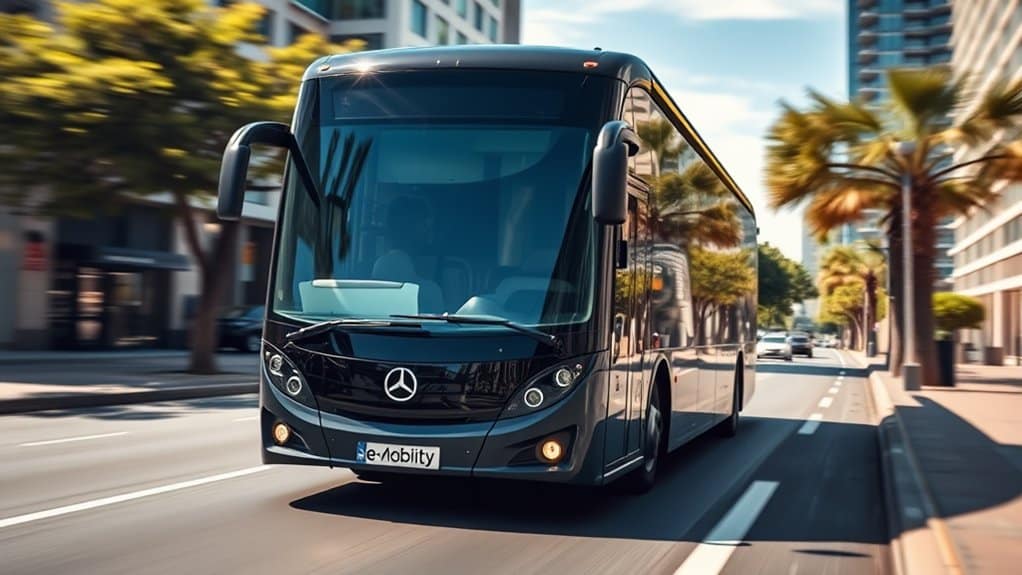
Electromobility in Uruguay is progressing, thanks to the thoughtful policies our government has crafted. Throughout my years in real estate here, I’ve noticed how such incentives don’t just propel eco-friendly transportation; they also enhance the appeal of properties with sustainable features. The government has really paved the way with financial incentives and tax exemptions that make owning an electric vehicle more appealing. It’s quite a remarkable shift.
For instance, subsidies for public transport entrench the viability of electric options, while duty-free importation stands out as a key driver, making electric vehicles more accessible. Then there’s the elimination of the Specific Internal Tax, a move that noticeably trims the costs of these vehicles, integrating seamlessly with Uruguay’s broader environmental goals.
Living in Montevideo, I’ve seen firsthand how these policies resonate with individuals and companies eager to embrace sustainable choices. The recent announcement of economic incentives for 100 electric vehicles is a significant development, with financial support up to US$ 500,000 allocated for the initiative, which encourages a blend of innovation and environmental responsibility that is pivotal for our future. It’s about enabling freedom of choice, without sacrificing our ecological commitments. This thoughtful strategy not only fosters e-mobility but also echoes throughout different sectors, including real estate, where sustainable features and designs are increasingly in demand.
Electric Vehicle Sales Growth
Uruguay’s electric vehicle sales have experienced remarkable growth, with a 477% year-over-year increase in battery electric vehicle sales recorded in June 2024, and a 200% year-over-year growth in the first five months of 2024, indicating a significant surge in demand. The market growth is further highlighted by the fact that electric vehicle sales are forecasted to double, reaching nearly 1,700 units in 2023, with a notable 125.7% year-over-year growth in passenger EV sales in 2022. As the country’s electric vehicle market continues to expand, with a 15% market share of battery electric vehicles in June 2024, and a 3.1% EV penetration rate forecasted for 2023, it is essential to examine the key factors driving this growth, including EV sales and market trends. The significant growth in electric vehicle sales can be attributed to the dominance of BYD in the market, with the company capturing a substantial share of the electric vehicle sales in Uruguay.
EV Sales
Electric vehicle sales in Uruguay have seen impressive growth, with 1,044 EVs sold in 2022. This is a substantial increase compared to the 548 units sold the previous year. The thriving market is supported by several key trends. For instance, the penetration rate of passenger electric vehicles is on the rise. Sales of electric commercial vehicles are also increasing, specifically in the light commercial segment, although heavy commercial vehicle sales have decreased.
It’s also worth noting how battery electric vehicles (BEVs) are gaining a bigger share of the market. This shift reflects a broader move toward freedom from fuel-dependent driving. As someone deeply familiar with Uruguay’s landscape, both literally and economically, I’ve observed that this trend is resonating well with many of my clients who are looking for greener and more efficient transportation options.
If you’re considering investing in an electric vehicle here, you might find it interesting to know that the popularity of EVs aligns with Uruguay’s commitment to renewable energy. Most of our electricity comes from natural and renewable sources, which makes owning an electric vehicle even more advantageous. Whether it’s chatting about the real estate market or the latest in EV trends, I’m always eager to share insights that help paint a clearer picture of our dynamic environment. The government’s incentives, including a tax exemption, have played a significant role in encouraging the adoption of electric vehicles, contributing to the country’s leadership in e-mobility in South America.
Market Growth
In Uruguay, the rise in electric vehicle sales is quite an interesting development. This growth is not just by chance; it’s the result of several impactful factors working together. Uruguay has always had a knack for advancing its renewable energy initiatives, and the government has been quite active in promoting green transportation. They’ve introduced a host of financial incentives that make electric vehicles (‘EVs,’ as many of us call them here) more accessible to residents.
We’ve also seen a growing awareness among consumers. People here are increasingly recognizing the importance of sustainable transportation. This conscious shift among Uruguayans is pushing the demand for electric vehicles higher. My experience in the real estate market tells me that a community’s modern needs often reflect in its investments, and transportation is certainly no exception.
The country’s high percentage of renewable energy also plays a significant role in making electric vehicles a more sustainable choice. Adding to this momentum, technological advancements in charging solutions are noticeable. Uruguay now hosts over 332 charging stations across the country. This wide-ranging network makes owning an EV more feasible and less worrisome for potential buyers who might have previously been concerned about charging availability.
All these efforts combined have a promising outlook for Uruguay’s EV market. Predictions suggest a significant rise in passenger EV sales for 2023. This isn’t just about increased sales, though; it’s about fostering a more sustainable and freedom-oriented transportation landscape. I see a parallel in real estate trends as well, where eco-friendly homes are becoming highly sought after, demonstrating a broader, societal shift towards sustainability. It’s a thrilling time to witness these changes unfold both in mobility and in living choices.
E Mobility Charging Infrastructure
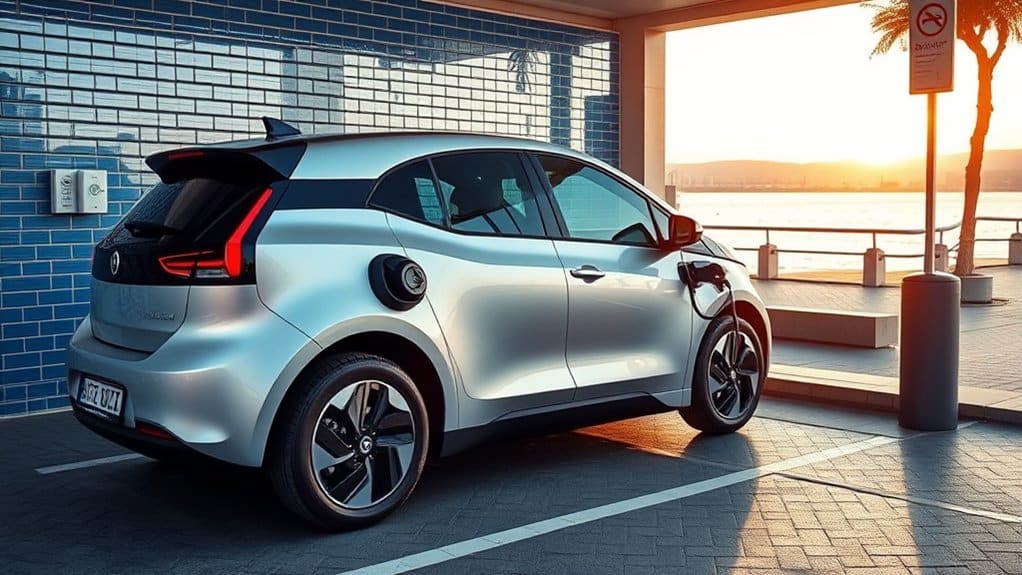
As the adoption of electric vehicles continues to rise, a strong and reliable charging infrastructure becomes increasingly vital to support this trend. Here in Uruguay, we’ve been making significant strides to enhance our network. One of the key improvements is increasing the accessibility of charging stations, ensuring they’re conveniently located for all users.
We’re also focusing on installing ultra-fast chargers, which drastically cut down the time users spend waiting for their vehicles to power up. This installation is crucial for those of us accustomed to the convenience of filling up at traditional gas stations. By reducing wait times, we’re making electric vehicles more practical for everyday use.
Additionally, increasing the convenience of charging experiences is essential. This enhancement directly leads to an improved user experience, giving electric vehicle owners more freedom and peace of mind on their journeys. With these advancements, Uruguay is positioning itself as a leader in sustainable transportation. Our commitment to expanding and improving this infrastructure demonstrates a clear understanding of the growing needs of electric vehicle owners. The new charging station features a central power unit that offers a high capacity for charging, further contributing to the country’s e-mobility efforts.
Renewable Energy Sources
Uruguay’s pursuit of e-mobility is heavily reliant on its ability to harness renewable energy sources, including hydroelectric power, wind energy, solar power, and biomass energy, which collectively form the backbone of its green energy environment. The country’s energy matrix is characterized by a significant presence of renewable power, with hydroelectricity and wind power constituting around 48% and 40% of its electricity generation, respectively, while solar power and biomass energy are gradually increasing their contribution. As Uruguay continues to transition towards a more sustainable transportation sector, the development and integration of these energy sources will be essential, necessitating a concerted effort to optimize their potential and ensure a steady supply of green energy to support the growing demand for e-mobility. The growth of e-mobility in Uruguay is also driven by the government’s initiatives to promote the use of renewable energy sources, which has led to an increase in the number of electric vehicles on the road, and is expected to further reduce the country’s reliance on fossil fuels.
Energy Sources
In Uruguay, we’ve embraced the shift from fossil fuels to renewable energy, and it’s truly changed the landscape of our country. Our natural resources lend themselves beautifully to generating clean power, making sustainability a practical and achievable goal. Over the years, I’ve seen firsthand how this commitment to renewable energy has become a linchpin in our national strategy. We harness various sources effectively and efficiently, creating a more sustainable environment for everyone.
Take hydroelectric energy, for example. With our abundant rivers, we’ve been able to tap into this resource extensively. It plays a major role in meeting our energy needs without compromising the environment. Wind energy is another favorite. You wouldn’t believe how much potential those breezy plains have for harnessing wind power! And let’s not forget solar energy. Our sunny days aren’t just great for the beaches; they also provide ample opportunity to capture solar power.
Biomass energy is another piece of this sustainable puzzle. By utilizing organic materials, we’re not only generating energy but also reducing waste in a clever and resourceful way. All of these sources collectively drive Uruguay’s interest in e-mobility, providing us with the freedom to innovate and progress.
As a seasoned real estate agent here, it’s fascinating to see how our commitment to sustainability enhances the quality of life and even influences property values. Embracing clean energy makes Uruguay a more attractive place to live, invest, and cherish. With a strong focus on energy sovereignty, Uruguay has been able to make significant strides in reducing poverty rates and creating jobs in the renewable sector, leading to a more stable and prosperous economy.
Renewable Power
In Uruguay, renewable power plays a key role in the nation’s energy strategy. With 99.25% of our electricity sourced from low-carbon options, we’ve set a benchmark for sustainable living. I’m Yolanda, a seasoned real estate agent in Uruguay, and I’ve witnessed firsthand how our country’s commitment to renewable energy has shaped not just the land but also our lifestyles.
Hydropower leads the charge, offering 48% of our electricity needs with a capacity of 1,500 MW. This is complemented by wind energy, which provides 36% of our supply. We also leverage biofuels for 13% of our needs and solar energy contributes another 3%, with a capacity of 270 MW. This diverse renewable mix allows us to step confidently into a future free from fossil fuels, ensuring a cleaner environment and paving the way for advances in e-mobility.
Our nation’s focus on sustainability extends beyond just energy. It’s influencing real estate trends too. Homes and businesses are increasingly being designed and built with energy efficiency in mind, aligning with the country’s green aspirations. Leading by example, Uruguay is not just adapting to a global trend but is also setting its standard for embracing innovation and environmental responsibility. As someone invested deeply in understanding how Uruguay’s environment affects real estate, I’m proud to share how our renewable energy progress is reshaping our communities. The significant ranking of #24 in global electricity generation is a notable achievement, with a carbon intensity of 50.46 gCO2eq/kWh being a key factor in this success.
Green Energy
Let me tell you a bit about Uruguay’s commitment to green energy, a cornerstone of our sustainable development. I’ve seen firsthand how our country’s energy landscape has been transformed, thanks to innovative efforts and diversified resources. We have cleverly harnessed the power of nature, ensuring a balanced energy mix that’s both efficient and responsible.
We have a strong foundation in hydroelectric power, which has been instrumental in our energy strategy for many years. The mighty rivers here have been put to good use, providing significant electricity while minimizing environmental impact.
Wind energy has seen impressive gains too. Up in the open stretches of Uruguay, those sweeping plains are now dotted with wind turbines. They’ve become an iconic part of the landscape, standing tall as symbols of our progress. In fact, wind power is a crucial player in our renewable energy portfolio.
Solar energy is also growing rapidly. Sunny skies are not just a part of our beautiful scenery but are increasingly powering our homes and businesses. The advancements in solar technology have made it more accessible and efficient, allowing us to tap into this abundant resource.
We’ve not neglected biomass energy either. This involves using organic materials to produce energy, helping us reduce waste and greenhouse gas emissions simultaneously. It’s another clever way Uruguay is leading the charge toward a more sustainable future.
Investments in renewable energy have been substantial, signaling a long-term commitment to these initiatives. As a result, our push toward green energy extends into areas like e-mobility, integrating wind and solar innovations to foster sustainable urban development. With a focus on becoming a leader in green hydrogen, our country is exploring new ways to utilize renewable sources for energy production and export.
This focus on clean energy isn’t just changing how we power our homes and cities; it’s also a selling point in real estate here. Buyers appreciate eco-conscious options, knowing they’re investing in a future that values our planet. Whether you’re looking to move to Uruguay or considering investments here, our green energy initiatives play a significant role in the ever-evolving market.
Fleet Electrification Trends
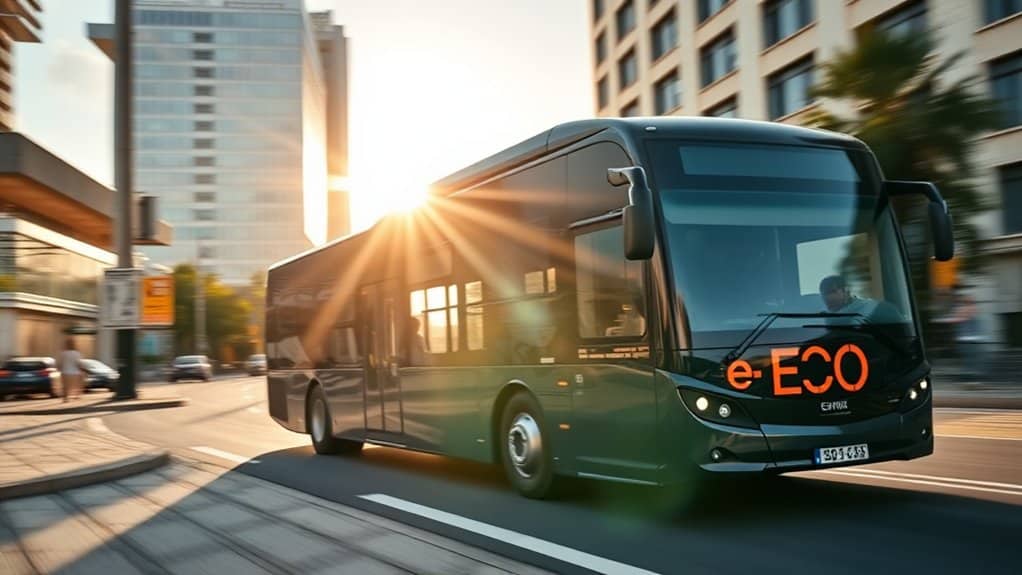
In Uruguay, we’re witnessing a remarkable shift as corporate fleets move from traditional Internal Combustion Engine (ICE) vehicles to sustainable alternatives. This change is a significant step towards reducing our carbon footprint here in the country. Embracing these greener options plays an essential role in corporate sustainability efforts by helping companies considerably cut down on emissions.
Our country is actively working towards reducing the presence of ICE vehicles to just 11%. There’s an encouraging focus on boosting the numbers of Hybrid Electric Vehicles (HEVs) to 46%, Plug-in Hybrid Electric Vehicles (PHEVs) to 15%, and Battery Electric Vehicles (BEVs) to 29%. Achieving these numbers not only underscores our commitment to a cleaner environment but also showcases our leadership in the region.
Investing in charging infrastructure is a critical part of this transition. By building a robust network to support these vehicles, we’re ensuring that our automotive ecosystem remains sustainable and efficient. This infrastructure is vital for supporting our progress toward e-mobility and ensures we’re on a path that effectively mitigates environmental harm. The country’s reliance on renewable energy sources is a key factor in the success of this transition, making Uruguay an exemplary model for other nations to follow.
In my years of working in real estate across Uruguay, I’ve seen firsthand how such advancements can positively impact local communities. The availability of eco-friendly vehicle options not only supports environmental goals but also enhances property values by promoting a cleaner, healthier living environment. It’s an exciting time to be part of such positive changes in our beautiful country.
Public Transport Electrification
Uruguay’s public transport sector is undergoing significant changes, driven by the need to reduce emissions and improve air quality, with bus electrification being a vital aspect, as companies like BYD, Higer, and Yutong lead the charge. The expansion of electric bus fleets, a key component of transport systems, is expected to accelerate, with CUTCSA, the largest public transport operator, already having received 100 electric buses from BYD, and plans to add more units from BYD and Higer. As the government sets ambitious targets, including achieving 100% public transit electrification by 2040, the focus on fleet expansion, bus electrification, and efficient transport systems will be essential to meeting these goals, and overcoming the challenges that lie ahead. The trust mechanism has been instrumental in facilitating the acquisition of new buses, with the Municipality of Montevideo acting as administrator and guarantor of Trust funds to promote electromobility and support the conversion of future revenue into current funds for fleet renewal.
Bus Electrification
Electrification of public transport is really taking off in Uruguay, with companies like BYD, Higer, and Yutong leading the charge. This transformation is significant for us, as it not only enhances urban mobility but also helps reduce our environmental footprint. In cities, the benefits are quite noticeable. For one, air quality has improved significantly, which is a boon for public health. With electric buses, we also enjoy the luxury of quieter streets, as they generate less noise compared to their diesel counterparts.
From an energy standpoint, these buses are more efficient, which is fantastic for sustainability. In my experience, lower operating costs are a big plus for transport operators, and that often translates to potential savings or improvements in service for the passengers. Then, there’s the reduced carbon footprint. This is something we can all appreciate, as it brings us a step closer to less pollution and a healthier environment, which is essential for preserving the beauty of our country.
Our commitment to electrification is reshaping urban areas, making them more livable and sustainably progressive. I’d say it’s a win-win for everyone involved, from the daily commuter to the long-term resident looking to invest in properties where modern conveniences align with environmental consciousness. The government’s initiative to promote electric vehicles, including the establishment of tax incentives, has been instrumental in driving this change forward.
Transport Systems
In recent years, I’ve seen firsthand how electrification in public transport is reshaping our cities here in Uruguay. It’s an exciting time. Strategic investments in charging infrastructure and robust government initiatives are key drivers of this transformation. Not to mention, the cooperation among public transportation operators has been crucial. Together, these factors are enhancing our urban mobility options while fostering sustainable transit solutions.
Uruguay is particularly well-positioned for this shift, thanks to our focus on renewable energy. With over 98% of our electricity sourced from sustainable means like wind and solar power, charging electric vehicles becomes not just viable but highly efficient. This synergy is bringing about significant changes in urban mobility, offering more freedom of movement than ever before.
The impact is profound, as we’re not just embracing electric public transport but leading the way in South America’s e-mobility landscape. By adopting innovative solutions, we’re contributing to a cleaner environment. It’s rewarding to see how these advancements align with Uruguay’s commitment to sustainability. As someone who takes pride in showcasing the unique charms of our country, I find these developments to be a delightful addition to the vibrant narrative of Uruguay’s progress. The recent delivery of 100 electric buses is a notable milestone in this journey, marking a significant step forward in our nation’s transport sector.
Fleet Expansion
Public transport in Uruguay is on an exciting journey of transformation, marked by the significant expansion of electric vehicle fleets. As a seasoned real estate agent with deep roots in Uruguay, I’ve seen firsthand how integral transport development is to our communities and their growth. Partnerships with operators such as CUTCSA are spearheading this change, and they’re making smart decisions with specifications like 385 kW batteries for their electric buses.
You might be interested to learn that electric buses from renowned manufacturers like BYD and Higer are already becoming familiar sights on our streets. Uruguayan initiatives are supported by trust funds specifically aimed at fleet renewal, which is crucial in achieving the ambitious goal of a 25% renewal by 2025. These buses aren’t just off-the-shelf models; they are customized to meet the unique demands of our local environments. Isn’t that fascinating?
Another critical piece of this puzzle is the investment in charging infrastructure, which ensures these vehicles can serve us efficiently and reliably. This thoughtful development supports not only convenience in travel but also aligns with sustainability goals. Uruguay’s commitment to e-mobility illustrates a clear path toward a greener future, a commitment reflected in its transport strategies.
With these advancements, the possibilities for enhanced freedom of movement are expanding, enabling Uruguayans to explore new opportunities and settings—something I deeply understand and appreciate in my line of work. As we support these innovative steps, we’re also nurturing a commitment to sustainability that’s exciting for both residents and those of us in the real estate sector. The country aims to achieve carbon neutrality by 2050, which will have a significant impact on the environment and the economy, driven by initiatives like the development of green hydrogen.
Electric Bus Adoption
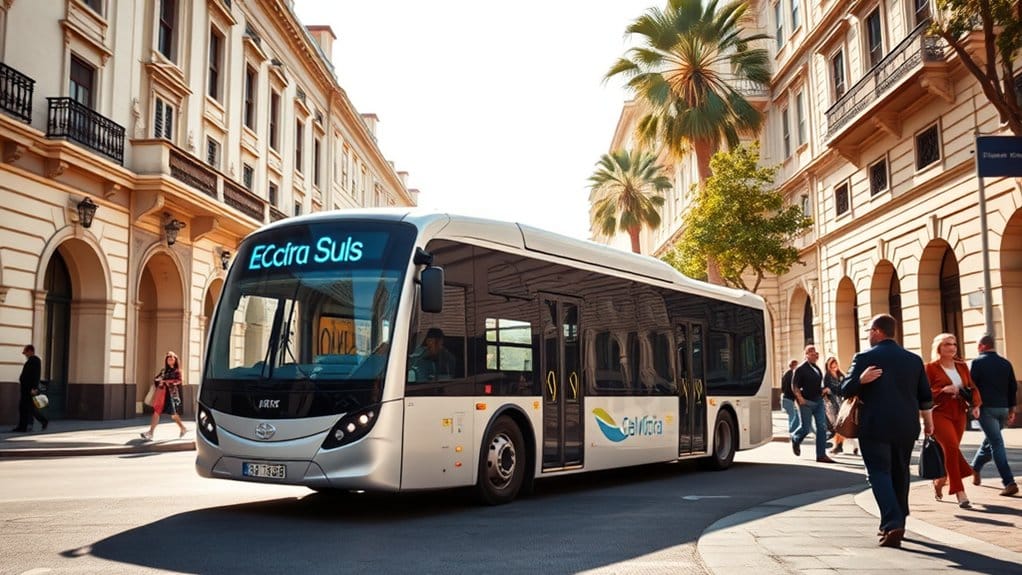
In Uruguay, we’re seeing some exciting changes in public transportation, thanks to the efforts behind electric bus adoption. Let me walk you through what’s happening. The government has implemented smart initiatives and provided subsidies to support this transition to cleaner transportation. It’s like seeing a house with great potential finally being renovated to match its promise.
In this case, the government is covering the cost difference between traditional diesel buses and their electric counterparts. This practical approach has already resulted in 32 electric buses hitting the streets, putting Uruguay ahead in South America. It’s somewhat akin to finding an undervalued gem of a property and transforming it into an asset everyone admires.
Why is this important? Well, these electric buses offer our citizens a healthier choice for their commutes. Beyond offering convenience, they contribute to a cleaner environment—a goal that’s becoming increasingly important in today’s world. This initiative aligns with Uruguay’s broader commitment to sustainability, which is evident in how we manage resources, protect our natural beauty, and treasure our communities.
And just like investing in a prime piece of real estate, Uruguay continues to invest in electric bus adoption. These efforts are not just about the present but are paving the way for a sustainable future, one step at a time. You can think of it as laying a strong foundation in real estate; the benefits will resonate for many years to come. The transformation is happening, and it’s a journey worth watching, much like a neighborhood on the rise. With the integration of electric buses, the country expects to achieve significant reductions in CO2 emissions, further enhancing its position as a leader in sustainable mobility.
Commercial Sector E Mobility
As someone who’s spent years navigating Uruguay’s bustling commercial landscape, I can tell you that the country’s approach to e-mobility is both progressive and practical. It’s fascinating to observe how government policies have meticulously paved the way for electric vehicle adoption here. Tax incentives are a key component, encouraging businesses to incorporate electric vehicles into their fleets without financial strain. Duty-free importation further eases the transition, making it economically viable for more entrepreneurs to explore this path.
The Subite program stands out for its role in providing financial support, making it feasible for more businesses to join the e-mobility movement. Meanwhile, the ever-expanding charging infrastructure is crucial, addressing one of the major hurdles to electric vehicle uptake. It’s not just about logistics; it’s about crafting a business environment that thrives on growth and investment in this sustainable avenue.
Uruguay’s favorable landscape for e-mobility is leading to a blend of freedom, innovation, and sustainability. As we witness this transformation, it becomes clear that the commercial sector is not just following but actively shaping the future of mobility. The commitment is evident, and the benefits are unfolding, offering exciting opportunities for those prepared to embrace them. With the support of government incentives, businesses in Uruguay are poised to capitalize on emerging trends in e-mobility and renewable energy, presenting a unique chance for foreign investment and partnerships, such as those with U.S. companies.
Sustainable Energy Matrix
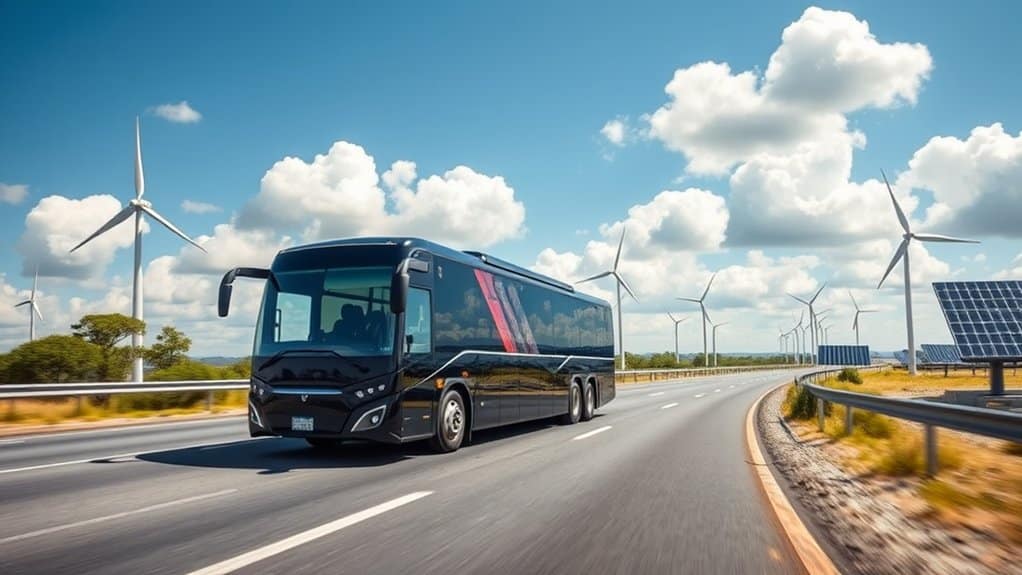
In Uruguay, we’ve done something truly impressive when it comes to sustainable energy. As a seasoned real estate agent here, I can tell you that our country is an excellent example for others aiming to revamp their energy systems. We’ve seen an incredible shift toward renewable energy, which now powers a startling 98-99.25% of our electricity. This change hasn’t just helped reduce our carbon emissions—it’s also brought along economic perks that have made a real difference in people’s lives.
Uruguay’s focus on sustainability has opened new avenues, including a surge in e-mobility. This shift highlights how a carefully strategized energy transition can pave the way for a nation to grow while keeping the environment in mind. People often ask me about the secret behind our success, and I’d say it’s all about commitment and long-term vision. We’ve shown that by prioritizing sustainable energy, we can chart a course towards a future that’s not only more eco-friendly but also economically viable. The nation is also making progress in achieving its goal of carbon neutrality by 2050, with a focus on hydrogen technology playing a crucial role in decarbonizing the transport and industry sectors.
Electric Vehicle Subsidies
Uruguay’s commitment to a sustainable energy matrix has laid the groundwork for a thriving e-mobility environment. Our nation is shaping a future where electric vehicles are not just a trend but a practical and accessible choice. Having worked for many years in real estate, I’ve noticed how these changes are subtly influencing the market and lifestyle here.
One of the cornerstones of this shift is the array of enticing incentives encouraging folks to consider electric vehicles. Imagine the savings when public transport goes electric and incentives align with these choices. There’s a sense of freedom in transitioning to sustainable transport without breaking the bank.
Our government has been proactive. There’s an exemption on taxes when you purchase an electric vehicle. This is a significant advantage, especially for those of us considering a purchase. And if you’re eyeing a hybrid or fully electric car, there’s an extra bonus waiting for you, making it easier to lean toward these eco-friendly options.
Leasing an electric vehicle is another area where you get financial support. It’s an option that makes going green more feasible, especially for businesses looking to modernize their fleets. And let’s not forget the duty-free import of electric vehicles and their equipment, a practical step that lowers initial barriers and encourages wider adoption.
As I see it, these incentives are not just policies; they are enablers. They empower both individuals and companies to make the switch to environmentally friendly transportation. The ripple effect is palpable—from reducing urban pollution to subtly increasing the attractiveness of properties in areas well-served by electric infrastructure. Uruguay is carving out a path of progressive transformation, one electric vehicle at a time. Additionally, the recent adjustment of the CIF value cap has significant implications for the automotive industry, affecting the availability of electric vehicles in the market.
E Mobility Market Trends
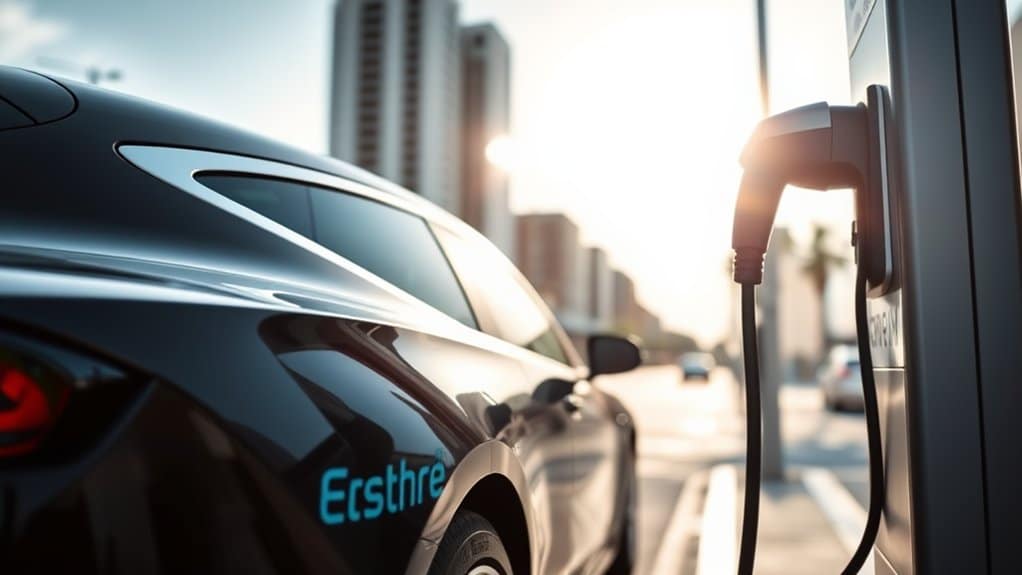
In Uruguay, the commitment to renewable energy is steering our e-mobility landscape toward an exciting future with electric vehicles. We’re seeing a shift in consumer preferences toward sustainable choices, which in turn is fueling market competition and driving technological innovation. With the increasing demand for electric vehicles, businesses are recognizing the need to adapt quickly. Investments in infrastructure and technology are becoming essential steps in meeting consumer expectations efficiently.
Interestingly, the used car market is growing as well, providing more affordable options for many. Semi-autonomous vehicles are gaining popularity too, as drivers embrace new levels of convenience and safety. Uruguay’s abundant electricity supply from renewable sources plays a crucial role in this transition. It’s positioning us to truly harness e-mobility trends and solidify our leadership in South America.
In my experience, understanding these trends not only aids in grasping current market dynamics but also in making informed decisions for the future. The global trend of decreasing battery prices is also impacting Uruguay’s market, making electric vehicles more accessible to the general public. It’s an exciting time, and Uruguay’s journey is certainly one to watch as we continue to innovate and lead in this sector.
Green Transportation Initiatives
In Uruguay, we’re seeing a wonderful shift towards e-mobility, a direction that reflects our green transportation initiatives. As someone who has been a part of this nation’s growth, it’s truly exciting to witness such a positive change. These initiatives are more than just policies; they’re a reflection of our commitment to sustainability and innovation. Whether you’re strolling through picturesque Montevideo neighborhoods or exploring the scenic routes of the countryside, you’ll notice new electric bus fleets providing efficient and eco-friendly public transportation.
Our cities are increasingly becoming pedestrian-friendly too. Non-motorized mobility options, like well-maintained cycling paths, are promoting a healthier, breathable environment. It’s all part of seamlessly integrating renewable energy sources into our daily lives, reducing carbon footprints, and preserving the natural beauty that’s so intrinsic to Uruguay’s charm.
Another fascinating development is our exploration of green hydrogen as a sustainable energy source. Imagine reducing emissions while fueling transport systems—this is the future we’re embracing. To support these advancements, comprehensive charging infrastructure is being developed across the country, ensuring that the shift to electric vehicles is as smooth as possible. The country’s energy grid, which is nearly renewable, supports these initiatives, making Uruguay an ideal place for e-mobility projects.
Uruguay’s determination to lead the way in e-mobility is palpable. By prioritizing these strategies, we’re setting a precedent for a greener, more sustainable future. With every step we take, there’s an emphasis on creating a lifestyle that harmonizes freedom with environmental integrity. As someone who understands the local landscape, I’m thrilled to share how these initiatives not only enhance our quality of life but also align with our values.
Electric Fleet Expansion
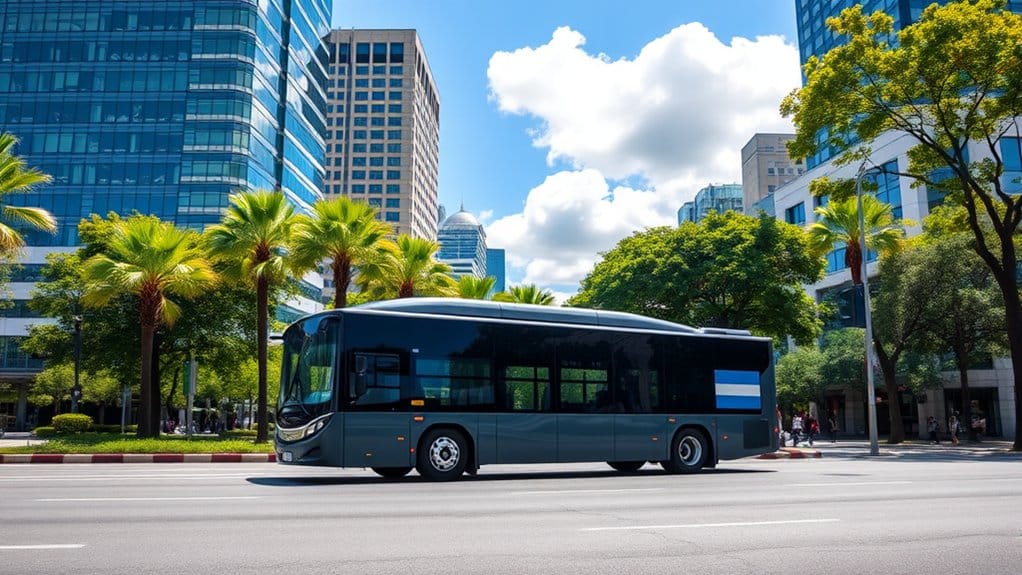
Electric vehicles are becoming more common, and this trend is accelerating as we see a notable increase in their registration and presence. Uruguay stands out as a leader in South America when it comes to electric vehicle adoption per capita, significantly boosting urban mobility. With around 5,950 registered electric vehicles, Uruguay surpasses many bigger nations in this respect.
In 2023, the sales of electric vehicles in Uruguay increased by an impressive 80.92%. By June 2024, there was a further 477% rise compared to the previous year. This upsurge not only expands the electric vehicle fleet but also strengthens urban mobility by fostering more widespread adoption of these vehicles.
The growth in electric vehicle sales can be attributed to initiatives such as the Subite programme, which has been instrumental in promoting electromobility.
In my years of experience as a real estate agent here in Uruguay, I’ve witnessed firsthand the many benefits of this electric revolution. It enhances our cities’ connectivity and contributes to a more sustainable environment, fitting perfectly into the eco-friendly ethos that many of us here in Uruguay hold dear. It’s an exciting time, and I’m thrilled to see how electric vehicles are shaping our urban landscape.



